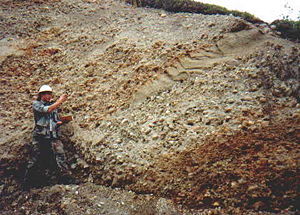Alluvium
- "Alluvial" redirects here.

Alluvium (from the Latin, alluvius, from alluere, "to wash against") is soil or sediments deposited by a river or other running water. Alluvium is typically made up of a variety of materials, including fine particles of silt and clay and larger particles of sand and gravel.
Flowing water associated with glaciers may also deposit alluvium, but deposits directly from ice are not alluvium (see glacial till).
A river is continually picking up and dropping solid particles of rock and soil from its bed throughout its length. Where the river flow is fast, more particles are picked up than dropped. Where the river flow is slow, more particles are dropped than picked up. Areas where more particles are dropped are called alluvial or flood plains, and the dropped particles are called alluvium.
Even small streams make alluvial deposits, but it is in the flood plains and deltas of large rivers that large, geologically-significant alluvial deposits are found.
The amount of matter carried by a large river is enormous. The names of many rivers derive from the color that the transported matter gives the water. For example, the Huang He in China is literally translated "Yellow River", and the Mississippi River in the United States is also called Big Muddy. It has been estimated that the Mississippi River annually carries 406 million tons of sediment to the sea[1], the Huang He 796 million tons, and the Po River in Italy 67 million tons[2].
Alluvium often contains valuable ores such as gold and platinum and a wide variety of gemstones. Such concentrations of valuable ores is termed a placer deposit.
Throughout history, many shallow lakes have been filled in with alluvium to leave fertile plains (alluvial soils are often very fertile). The alluvial mud annually deposited by the Nile has enabled the Egyptians to grow crops since at least the 4th millennium B.C.E. without artificial fertilization.
Since the construction of the Aswan Dam on The Nile in Egypt, 95% of the alluvium deposits at the mouth of the Nubia-Nasser Lake are gone, thus depriving the Nile delta of its fertility. Since 1964, 3.8 billion cubic meters of sediments have deposited in this man-made lake. Proposals have been made to dredge this alluvium and pump it in slurry pipelines to shore where it can be used to fertilize the desert.[3]
See also
- Alluvial desert
- Alluvial fan
- Alluvial plain
- Alluvion
- Colluvium
- Eluvium
- Fluvial
- Illuvium
Notes
- ↑ Mathur, Anuradha and Dilip da Cunha (2001). Mississippi Floods: Designing a Shifting Landscape. New Haven, CT: Yale University Press. ISBN 0-300-08430-7.
- ↑ Dill, William A. (1990). Inland fisheries of Europe. Rome, Italy: UN Food and Agriculture Organization. ISBN 92-5-102999-7.
- ↑ ABULNAGA Baha - EL-SAMMANY Moustafa " Mine Over Water" International water power & dam construction (Int. water power dam constr.) ISSN 0306-400X CODEN IWPCDM International water power and dam construction - 2003, vol. 55, no11, pp. 22-26
ReferencesISBN links support NWE through referral fees
External links
- "Dennis Garrett", [Blue Ribbon Mine, Alaska]
Credits
New World Encyclopedia writers and editors rewrote and completed the Wikipedia article in accordance with New World Encyclopedia standards. This article abides by terms of the Creative Commons CC-by-sa 3.0 License (CC-by-sa), which may be used and disseminated with proper attribution. Credit is due under the terms of this license that can reference both the New World Encyclopedia contributors and the selfless volunteer contributors of the Wikimedia Foundation. To cite this article click here for a list of acceptable citing formats.The history of earlier contributions by wikipedians is accessible to researchers here:
The history of this article since it was imported to New World Encyclopedia:
Note: Some restrictions may apply to use of individual images which are separately licensed.
